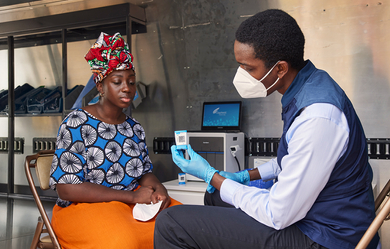5m Read
March 28, 2025
COMMUNITY AND GLOBAL HEALTH
Article
Fighting TB is Everything: How South Africa has Landed a Significant Blow on its Tuberculosis Burden
Few things in global health are as worth investing in as childhood vaccination programs. Data from a new study suggest molecular diagnostics for tuberculosis might be one of them.
Other countries can be forgiven for looking enviously at South Africa’s progress in tackling tuberculosis (TB). Over the past decade, the country has slashed its TB incidence rate by more than half—an impressive feat in global public health.1, 2 A recent study in BMJ Global Health sheds light on a key factor behind this success: molecular diagnostics.1
The study provides a 10-year health and economic evaluation of South Africa’s country-wide molecular diagnostics program, spanning 2013 to 2022 (see figure for more on the study). The TB program saw a transition from smear microscopy to molecular testing with the GeneXpert® systems and Xpert® tests through Cepheid’s Global Access program.
The switch to molecular testing averted an additional 1 million disability-adjusted life years, or DALYs. In real terms, it helped save a million years of people’s lives that would have been lost too soon or spent in poor health.
The economic impact of these health gains is equally as striking: every U.S. $1 spent on TB diagnostics returned $20.3 of economic value. For comparison, the authors state that a dollar spent in childhood vaccination programs, often considered one of the most valuable public health interventions, sees a return of around $16.
Why Molecular Diagnostics Worked
Smear microscopy, while cheaper upfront, is slower and less accurate than molecular diagnostics. Delayed diagnoses mean prolonged infectiousness, higher transmission, and worse patient outcomes. By contrast, molecular tests detect TB (including resistant strains) faster, enabling earlier treatment and curbing transmission.
Diagnostics were just one piece of a broader TB strategy. The more than 50% reduction in TB incidence in the country also reflects expanded treatment options, improved accessibility, and better HIV care (HIV weakens the immune system and increases an individual’s risk of TB).

Doctor and patient at GeneXpert mobile testing site
A Model of Commitment
South Africa was an early adopter of WHO guidelines to switch from smear microscopy to molecular testing.3 The Xpert® MTB/RIF tests were launched in 2010 and were already widely adopted in the country by 2011.
But a diagnostic machine without a supporting health infrastructure is like having the latest smartphone without a signal. The signal, in this case, was South Africa’s National Health Laboratory Service (NHLS), which built a robust network to ensure 85% of the population—and 100% of the public sector—had access to testing.1 Mobile units, daily specimen transport, and rapid results delivery bridged the gap between investment and impact.
A Global Gap
South Africa’s impressive 85% molecular diagnostic coverage is in stark contrast to the situation in many countries. An estimated 47% of the global population have limited, if any, access to even basic diagnostics.4
Data from this health economic study will be of interest to other countries and donors in the global TB fight. Especially given that before this study, few high-level studies were available showing the direct and long-term health and economic impacts of strong and well-distributed public health diagnostic programs.
South Africa’s decade-long bet on diagnostics has paid off. The country now stands as a leader in the fight against TB—proof that with the right tools, investment, and political will, even the deadliest infectious diseases can be beaten.
References:
- Nichols BE, et al. BMJ Glob Health 2024;9(12):e015830
- Tuberculosis report: South Africa: available at https://worldhealthorg.shinyapps.io/tb_profiles/?_inputs_&tab=%22charts%22&lan=%22EN%22&iso2=%22ZA%22&entity_type=%22country%22 (Accessed March 18, 2025)
- da Dilva MP, et al. Diagnostics 2023;13:3253.
- Fleming KA, et al. Lancet 2021;398:1997–2050
Read Next
MORE








